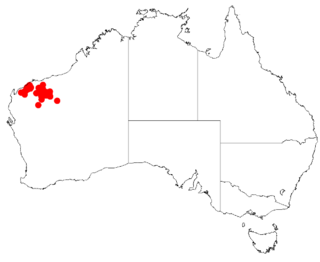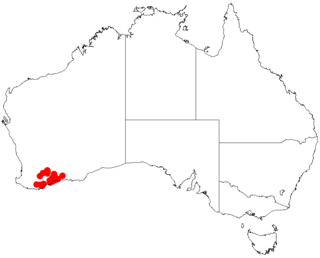
Acacia brachypoda, known colloquially as western wheatbelt wattle or Chinocup wattle, is an endangered species of Acacia restricted to a small locality in western Australia's wheatbelt.

Acacia arcuatilis is a shrub belonging to the genus Acacia and the subgenus Juliflorae that is endemic to south western parts of Australia.

Acacia atkinsiana, commonly known as Atkin's wattle, is a shrub belonging to the genus Acacia and the subgenus Juliflorae endemic to Australia. The indigenous peoples of the area where the shrub is found, the Kurrama peoples, know the shrub as Bilari or Pilarri.

Acacia desertorum is a shrub belonging to the genus Acacia and the subgenus Juliflorae that is endemic to western Australia.

Acacia latior is a shrub belonging to the genus Acacia and the subgenus Juliflorae that is endemic to western Australia.
Acacia sulcaticaulis, also commonly known as the Mount Mulgine fluted wattle, is a shrub or tree belonging to the genus Acacia and the subgenus Juliflorae that is native to a small area in western Australia.

Acacia tetraneura is a shrub belonging to the genus Acacia and the subgenus Juliflorae that is endemic to western Australia.
Acacia blaxellii, also known as Blaxell's wattle, is a shrub belonging to the genus Acacia and the subgenus Phyllodineae endemic to Western Australia.

Acacia merrickiae is a shrub belonging to the genus Acacia and the subgenus Phyllodineae that is endemic to a small area of south western Australia.

Acacia pachypoda is a shrub belonging to the genus Acacia and the subgenus Phyllodineae that is endemic to south western Australia.

Acacia ryaniana is a shrub of the genus Acacia and the subgenus Phyllodineae that is endemic to an area along the west coast of Australia.

Acacia anfractuosa is a shrub or tree of the genus Acacia and the subgenus Plurinerves that is endemic to Western Australia.

Acacia hadrophylla is a shrub of the genus Acacia and the subgenus Plurinerves that is endemic to south western Australia.

Acacia pharangites, commonly known as Wongan gully wattle, is a shrub of the genus Acacia and the subgenus Plurinerves that is endemic to a small area of south western Australia and is listed as endangered according to the Environment Protection and Biodiversity Conservation Act 1999.

Acacia roycei is a shrub or tree of the genus Acacia and the subgenus Plurinerves that is endemic to an area of western Australia.

Acacia tetanophylla is a shrub of the genus Acacia and the subgenus Plurinerves that is endemic to an area of south western Australia.
Acacia torticarpa is a shrub of the genus Acacia and the subgenus Plurinerves that is endemic to a small area in western Australia.

Acacia undosa is a shrub of the genus Acacia and the subgenus Plurinerves that is endemic to an area of south western Australia.

Acacia veronica, commonly known as Veronica's wattle, is a shrub or tree of the genus Acacia and the subgenus Plurinerves that is endemic to a small area of south western Australia.

Acacia wilsonii, also known as Wilson's wattle, is a shrub of the genus Acacia and the subgenus Plurinerves that is endemic to a small area of western Australia. It was listed as an endangered species in 2018 according to the Environment Protection and Biodiversity Conservation Act 1999 by Australian authorities and according to Biodiversity Conservation Act 2016 by Western Australian authorities.


















